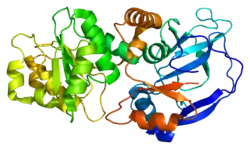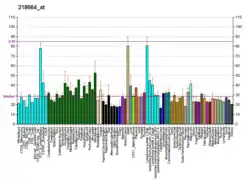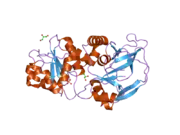MECR
Trans-2-enoyl-CoA reductase, mitochondrial is an enzyme that in humans is encoded by the MECR gene.[5][6][7]
| MECR | |||||||||||||||||||||||||||||||||||||||||||||||||||
|---|---|---|---|---|---|---|---|---|---|---|---|---|---|---|---|---|---|---|---|---|---|---|---|---|---|---|---|---|---|---|---|---|---|---|---|---|---|---|---|---|---|---|---|---|---|---|---|---|---|---|---|
 | |||||||||||||||||||||||||||||||||||||||||||||||||||
| |||||||||||||||||||||||||||||||||||||||||||||||||||
| Identifiers | |||||||||||||||||||||||||||||||||||||||||||||||||||
| Aliases | MECR, CGI-63, FASN2B, NRBF1, mitochondrial trans-2-enoyl-CoA reductase, ETR1, DYTOABG | ||||||||||||||||||||||||||||||||||||||||||||||||||
| External IDs | OMIM: 608205 MGI: 1349441 HomoloGene: 5362 GeneCards: MECR | ||||||||||||||||||||||||||||||||||||||||||||||||||
| |||||||||||||||||||||||||||||||||||||||||||||||||||
| |||||||||||||||||||||||||||||||||||||||||||||||||||
| |||||||||||||||||||||||||||||||||||||||||||||||||||
| |||||||||||||||||||||||||||||||||||||||||||||||||||
| |||||||||||||||||||||||||||||||||||||||||||||||||||
| Wikidata | |||||||||||||||||||||||||||||||||||||||||||||||||||
| |||||||||||||||||||||||||||||||||||||||||||||||||||
Structure
The MECR gene is located on the 1st chromosome, with its specific location being 1p35.3.[7] The gene contains 15 exons.[7] MECR encodes a 21.2 kDa protein that is composed of 189 amino acids; 10 peptides have been observed through mass spectrometry data.[8][9]
Function
The mtFAS pathway is essential for producing octanoic acid that is used to synthesize lipoic acid, which is essential for aerobic metabolism. The protein encoded by MECR is an oxidoreductase that catalyzes the last step in mtFAS.[10]
A Purkinje cell specific knock out of the Mecr gene in mice leads to neurodegeneration.[11]
Clinical significance
Genetic mutations to MECR have been suggested to cause MEPAN Syndrome, a neurometabolic disorder in humans that involves disruptions in the pathway involved in mitochondrial fatty acid synthesis (mtFAS). MEPAN patients were found to harbor recessive mutations in MECR, and typically present with childhood-onset dystonia, optic atrophy, and basal ganglia signal abnormalities on MRI.[12]
References
- GRCh38: Ensembl release 89: ENSG00000116353 - Ensembl, May 2017
- GRCm38: Ensembl release 89: ENSMUSG00000028910 - Ensembl, May 2017
- "Human PubMed Reference:". National Center for Biotechnology Information, U.S. National Library of Medicine.
- "Mouse PubMed Reference:". National Center for Biotechnology Information, U.S. National Library of Medicine.
- Masuda N, Yasumo H, Furusawa T, Tsukamoto T, Sadano H, Osumi T (October 1998). "Nuclear receptor binding factor-1 (NRBF-1), a protein interacting with a wide spectrum of nuclear hormone receptors". Gene. 221 (2): 225–33. doi:10.1016/S0378-1119(98)00461-2. PMID 9795230.
- Miinalainen IJ, Chen ZJ, Torkko JM, Pirilä PL, Sormunen RT, Bergmann U, Qin YM, Hiltunen JK (May 2003). "Characterization of 2-enoyl thioester reductase from mammals. An ortholog of YBR026p/MRF1'p of the yeast mitochondrial fatty acid synthesis type II". The Journal of Biological Chemistry. 278 (22): 20154–61. doi:10.1074/jbc.M302851200. PMID 12654921.
- "Entrez Gene: MECR mitochondrial trans-2-enoyl-CoA reductase".
- ]Zong NC, Li H, Li H, Lam MP, Jimenez RC, Kim CS, Deng N, Kim AK, Choi JH, Zelaya I, Liem D, Meyer D, Odeberg J, Fang C, Lu HJ, Xu T, Weiss J, Duan H, Uhlen M, Yates JR, Apweiler R, Ge J, Hermjakob H, Ping P (October 2013). "Integration of cardiac proteome biology and medicine by a specialized knowledgebase". Circulation Research. 113 (9): 1043–53. doi:10.1161/CIRCRESAHA.113.301151. PMC 4076475. PMID 23965338.
- "Mitochondrial trans-2-enoyl-CoA reductase". Cardiac Organellar Protein Atlas Knowledgebase (COPaKB).
- Nowinski SM, Van Vranken JG, Dove KK, Rutter J (October 2018). "Impact of Mitochondrial Fatty Acid Synthesis on Mitochondrial Biogenesis". Current Biology. 28 (20): R1212–R1219. doi:10.1016/j.cub.2018.08.022. PMC 6258005. PMID 30352195.
- Nair RR, Koivisto H, Jokivarsi K, Miinalainen IJ, Autio KJ, Manninen A, et al. (November 2018). "Impaired Mitochondrial Fatty Acid Synthesis Leads to Neurodegeneration in Mice". The Journal of Neuroscience. 38 (45): 9781–9800. doi:10.1523/JNEUROSCI.3514-17.2018. PMC 6595986. PMID 30266742.
- Heimer G, Kerätär JM, Riley LG, Balasubramaniam S, Eyal E, Pietikäinen LP, et al. (December 2016). "MECR Mutations Cause Childhood-Onset Dystonia and Optic Atrophy, a Mitochondrial Fatty Acid Synthesis Disorder". American Journal of Human Genetics. 99 (6): 1229–1244. doi:10.1016/j.ajhg.2016.09.021. PMC 5142118. PMID 27817865.
Further reading
- Torkko JM, Koivuranta KT, Miinalainen IJ, Yagi AI, Schmitz W, Kastaniotis AJ, Airenne TT, Gurvitz A, Hiltunen KJ (September 2001). "Candida tropicalis Etr1p and Saccharomyces cerevisiae Ybr026p (Mrf1'p), 2-enoyl thioester reductases essential for mitochondrial respiratory competence". Molecular and Cellular Biology. 21 (18): 6243–53. doi:10.1128/MCB.21.18.6243-6253.2001. PMC 87346. PMID 11509667.
- Maruyama K, Sugano S (January 1994). "Oligo-capping: a simple method to replace the cap structure of eukaryotic mRNAs with oligoribonucleotides". Gene. 138 (1–2): 171–4. doi:10.1016/0378-1119(94)90802-8. PMID 8125298.
- Suzuki Y, Yoshitomo-Nakagawa K, Maruyama K, Suyama A, Sugano S (October 1997). "Construction and characterization of a full length-enriched and a 5'-end-enriched cDNA library". Gene. 200 (1–2): 149–56. doi:10.1016/S0378-1119(97)00411-3. PMID 9373149.
- Lai CH, Chou CY, Ch'ang LY, Liu CS, Lin W (May 2000). "Identification of novel human genes evolutionarily conserved in Caenorhabditis elegans by comparative proteomics". Genome Research. 10 (5): 703–13. doi:10.1101/gr.10.5.703. PMC 310876. PMID 10810093.





